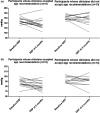Optimizing Precision of Hypertension Care to Maximize Blood Pressure Control: A Pilot Study Utilizing a Smartphone App to Incorporate Plasma Renin Activity Testing
- PMID: 33142006
- PMCID: PMC7993275
- DOI: 10.1111/cts.12922
Optimizing Precision of Hypertension Care to Maximize Blood Pressure Control: A Pilot Study Utilizing a Smartphone App to Incorporate Plasma Renin Activity Testing
Abstract
Only half of patients with hypertension (HTN) respond to any given antihypertensive medication. Heterogeneity in pathophysiologic pathways underlying HTN is a major contributor. Personalizing antihypertensive therapy could improve blood pressure (BP) reduction. The objective of this study was to assess the effect of pragmatic implementation of a personalized plasma renin activity (PRA)-based smartphone app on improving BP reduction. Patients with untreated or treated but uncontrolled HTN were recruited. BP and PRA were measured at baseline with final BP measured at 6 months. Patient's information was entered into the app and treatment recommendations were returned. Clinicians were at liberty to follow or disregard the app's recommendations. BP levels and percent BP control among patients whose clinicians did and did not follow the app's recommendations were compared using independent t-test and Fisher's exact test, respectively. Twenty-nine European American patients were included (38% women) with mean age of 52 ± 9 years and median PRA of 1.3 ng/mL/hr (interquartile range 0.5-3.1 ng/mL/hr). Participants whose clinicians followed the app's recommendations (n = 16, 55%) as compared with those whose clinicians did not (n = 13, 45%), had a greater reduction in 6-month systolic BP (-15 ± 21 vs. -3 ± 21 mm Hg; adjusted-P = 0.1) and diastolic BP (-8 ± 8 vs. -1 ± 8 mm Hg; adjusted-P = 0.04). BP control at 6 months tended to be greater among patients whose clinicians accepted the app's recommendations vs. those whose clinicians did not (63% vs. 23%, P = 0.06). This pilot study demonstrates that acceptance of the app's recommendations was associated with a greater BP reduction. Future studies to confirm these pilot findings are warranted.
Trial registration: ClinicalTrials.gov NCT02814552.
© 2020 The Authors. Clinical and Translational Science published by Wiley Periodicals LLC on behalf of the American Society for Clinical Pharmacology and Therapeutics.
Conflict of interest statement
The authors declared no competing interests for this work.
Figures



Similar articles
-
Does aldosterone-to-renin ratio predict the antihypertensive effect of the aldosterone antagonist spironolactone?Am J Hypertens. 2005 Dec;18(12 Pt 1):1631-5. doi: 10.1016/j.amjhyper.2005.06.010. Am J Hypertens. 2005. PMID: 16364838
-
Changes in Plasma Renin Activity After Renal Artery Sympathetic Denervation.J Am Coll Cardiol. 2021 Jun 15;77(23):2909-2919. doi: 10.1016/j.jacc.2021.04.044. Epub 2021 May 3. J Am Coll Cardiol. 2021. PMID: 33957242 Clinical Trial.
-
Fixed Low-Dose Triple Combination Antihypertensive Medication vs Usual Care for Blood Pressure Control in Patients With Mild to Moderate Hypertension in Sri Lanka: A Randomized Clinical Trial.JAMA. 2018 Aug 14;320(6):566-579. doi: 10.1001/jama.2018.10359. JAMA. 2018. PMID: 30120478 Free PMC article. Clinical Trial.
-
Plasma renin testing to guide antihypertensive therapy.Curr Hypertens Rep. 2015 Jan;17(1):506. doi: 10.1007/s11906-014-0506-0. Curr Hypertens Rep. 2015. PMID: 25432898 Review.
-
Diagnosis and Treatment of Monogenic Hypertension in Children.Yonsei Med J. 2023 Feb;64(2):77-86. doi: 10.3349/ymj.2022.0316. Yonsei Med J. 2023. PMID: 36719014 Free PMC article. Review.
Cited by
-
Metabolomics Signature of Plasma Renin Activity and Linkage with Blood Pressure Response to Beta Blockers and Thiazide Diuretics in Hypertensive European American Patients.Metabolites. 2021 Sep 21;11(9):645. doi: 10.3390/metabo11090645. Metabolites. 2021. PMID: 34564461 Free PMC article.
References
-
- Virani, S.S. et al. Heart disease and stroke statistics‐2020 update: a report from the American Heart Association. Circulation 141, e139–e596 (2020). - PubMed
-
- World Health Organization (WHO) . World Health Organization Global status report on noncommunicable diseases 2014 (Geneva, Switzerland, World Health Organization, 2015).
-
- Sundström, J. , et al. Effects of blood pressure reduction in mild hypertension: a systematic review and meta‐analysis. Ann. Intern. Med. 162, 184–191 (2015). - PubMed
-
- Clement, D.L. Poor blood pressure control: what can we do? J. Hypertens. 35, 1368–1370 (2017). - PubMed
Publication types
MeSH terms
Substances
Associated data
Grants and funding
LinkOut - more resources
Full Text Sources
Medical
Research Materials

